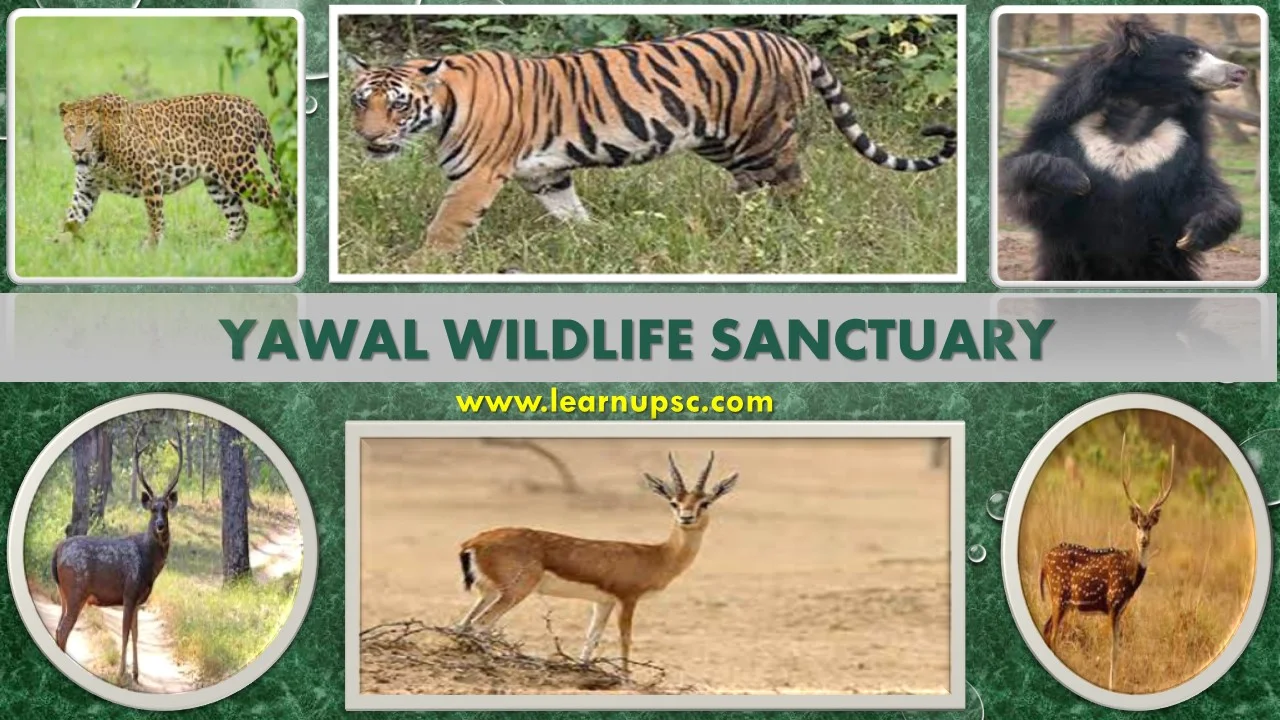Yawal Wildlife Sanctuary UPSC
Yawal Wildlife Sanctuary is a protected area located in the state of Maharashtra, India. The sanctuary is known for its diverse flora and fauna, including various species of mammals, birds, reptiles, and plants.
Yawal Wildlife Sanctuary lies along the banks of the rivers Anner and Manjal that flows towards the adjacent border of Madhya Pradesh.
The scenic landscape consisting of dry deciduous forests with trees of teak, salai, jamun and tendu and more found in large numbers. The region supports animals such as tigers, leopards, sambar, chinkara etc., as well as birds and reptiles.
|
Table of Contents
|
Yawal Wildlife Sanctuary Location
Yawal Wildlife Sanctuary is located in the Yawal Tehsil of the Jalgaon District in the state of Maharashtra, India.
Yawal Wildlife Sanctuary Nearest Airport:
The nearest airport to Yawal Wildlife Sanctuary is Jalgaon, Maharashtra. It's situated at a distance of approximately 50 kilometers from Yawal Wildlife Sanctuary. This airport offers domestic flights to various major cities in India.
Yawal Wildlife Sanctuary Nearest Railway Station:
The nearest railway station to Yawal Wildlife Sanctuary is Raver Railway Station, which is around 25 kilometers away. The sanctuary can be reached from this railway station by road.
Yawal Wildlife Sanctuary History
Yawal Wildlife Sanctuary has a history tied to its conservation and protection efforts.
Establishment and Recognition: In 1969, Yawal Wildlife Sanctuary was established to protect the diverse flora and fauna of the region. The sanctuary was officially recognized by the government to provide a safe haven for various plant and animal species.
Conservation Efforts: Over the years, the sanctuary has been managed with the goal of conserving its natural resources and promoting biodiversity. The dry deciduous forests, rivers, and varied landscapes make it an important area for conservation.
Tourism and Awareness: The sanctuary has also gained attention as a destination for naturalists, photographers, and wildlife enthusiasts. Its scenic beauty and diverse wildlife draw visitors who are interested in observing and learning about the local ecosystem.
Yawal Wildlife Sanctuary Area
Yawal Wildlife Sanctuary covers an area of approximately 177.52 square kilometers (68.7 square miles). This area is dedicated to the conservation of various flora and fauna, including dry deciduous forests, rivers, and diverse wildlife.
Yawal Wildlife Sanctuary River
Yawal Wildlife Sanctuary is bordered by the rivers Anner and Manjal. These rivers flow along the edges of the sanctuary and contribute to the diverse ecosystem within its boundaries.
Rivers play a crucial role in shaping the landscape, providing water sources for both the wildlife and the vegetation, and adding to the overall biodiversity of the sanctuary.
The Anner and Manjal rivers offer opportunities for various species of animals and plants to thrive in the sanctuary's environment. They also contribute to the scenic beauty of the area, making it an appealing destination for visitors interested in nature and wildlife.
Yawal Wildlife Sanctuary Flora
Yawal Wildlife Sanctuary is known for its diverse flora, with a range of plant species adapted to the dry deciduous forest ecosystem. Here are some common types of flora that can be found in the sanctuary:
- Teak
- Salai
- Anjan
- Ain
- Shisam
- Haldu
- Tiwas
- Khair
- Charoli
- Jamun
- Tendu
- Awala
- Bamboo
Yawal Wildlife Sanctuary Fauna (Yawal Wildlife Sanctuary Animals)
Yawal Wildlife Sanctuary is home to a variety of fauna, including mammals, birds, reptiles, and more. Here are some of the common and notable species that can be found within the sanctuary:
Mammals:
- Tiger
- Leopard
- Sambar
- Chinkara
- Barking Deer
- Bluebull
- Sloth Bear
- Striped Hyaena
- Jackal
- Fox
- Wolf
- Wild Boar
- Jungle Cat
- Palm Civet
- Wild Dog
- Flying Squirrel
Birds:
- Peacock
- Nilgiri Wood Pigeon
- Malabar Grey Hornbill
- White-bellied Blue Flycatcher
- Crimson-backed Sunbird
Reptiles:
- Indian Rock Python
- Dhaman, Indian Cobra
- Russell’s Viper
- Checkered Keelback
- Common Monitor
Yawal Wildlife Sanctuary UPSC Questions
Q. What is Yawal Wildlife Sanctuary famous for?
A. Yawal Wildlife Sanctuary is famous for several reasons:
(i) Biodiversity: The sanctuary is known for its rich biodiversity, encompassing a wide range of plant and animal species. It provides a habitat for various mammals, birds, reptiles, and other creatures, contributing to the overall ecological health of the region.
(ii) Tiger Population: Yawal Wildlife Sanctuary is recognized for its population of tigers. While tiger sightings might be rare due to the elusive nature of these big cats, their presence adds to the sanctuary's significance as a protected area for endangered species.
(iii) Flora Variety: The sanctuary's dry deciduous forests are home to diverse plant species, including teak, salai, jamun, and tendu trees. This flora supports the entire ecosystem and provides resources for the wildlife that inhabits the area.
(iv) Scenic Landscape: The sanctuary's landscape, including the presence of rivers like Anner and Manjal, adds to its appeal. The combination of forests, water bodies, and varied terrain makes it an attractive destination for nature enthusiasts, photographers, and tourists.
(v) Wildlife Conservation: Yawal Wildlife Sanctuary plays a crucial role in conserving the natural habitats of various species. The efforts to protect and manage the sanctuary contribute to maintaining the delicate balance between human activities and the needs of the wildlife.
(vi) Ecotourism: The sanctuary's diverse wildlife and picturesque surroundings have attracted naturalists, wildlife photographers, and ecotourists. Visitors come to observe the flora and fauna in their natural habitat, contributing to local tourism and raising awareness about conservation.


No comments:
Post a Comment